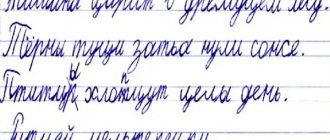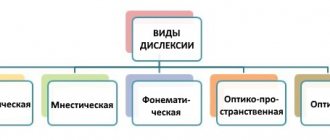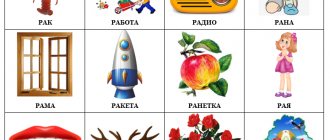Dysgraphia
- Specially selected speech material is also used to practice problem areas in writing and exercises for correction:
1. Clap or tap out the word syllable by syllable and name their number.
2. Be able to identify vowel sounds in a word, learn the basic rule of syllabic division: there are as many syllables in a word as there are vowel sounds.
3. Be able to isolate a vowel sound from a syllable and word. Determine the vowel sound and its place in the word (beginning, middle, end of the word).
4. Name the vowels in the word.
5. Write down only the vowels of the given word.
6. Select vowel sounds and find the corresponding letters.
7. Repeat the word syllable by syllable. Count the number of syllables.
8. Determine the number of syllables in the named words. Raise the corresponding number.
9. Write down the words in two columns (split the pictures into 2 groups) depending on the number of syllables.
10. Select the first syllable from the names of the pictures and write it down.
11. Combine syllables in a word, sentence, read the resulting word or sentence (for example: “beehive”, “house”, “car”, “moon”, “toad”). After highlighting the first syllables, the sentence is obtained: There is a puddle near the house.
12. Identify the missing syllable in a word using a picture:
__buzz, ut__, lod__, ka__, ka__dash.
13. Compose a word from syllables given in disorder (nok, tsyn, las, toch, forest, ka).
14. Find words in a sentence with a certain number of syllables.
Game “Guess who I'm calling?”
Goal: developing the ability to select words with a given number of syllables.
The teacher invites those children whose names consist of as many syllables to stand up as he claps.
For example: the teacher claps 3 times, the students count, then stand up (Se-ryo-zha, A-ri-na).
Game “Changes”.
Goals: development of the ability to compose words; accumulation of syllable images in memory.
Equipment: cards with syllables (4–6) for each player.
The teacher names two syllables, the children find cards with these syllables and first compose one word, then, rearranging the syllables, another: sos, na; tea. CA; spring; kA, mouse; jar; la, ska”ni, tka; ra. But; Which.
Game “Chain”.
Goal: developing the ability to select words based on one given syllable.
One of the students writes a word on the board syllable by syllable, the next one selects a word that begins with the next syllable of the given word (ok-no, no-ra, ra-ma).
Game “If I meet a word on the road, I’ll break it into syllables.”
Goal: development of syllable skills, attention, speed of thinking.
The teacher throws a ball to the children and names one-, two- and three-syllable words. The child who catches the ball determines the number of syllables, names them and passes the ball back. You can invite children to pronounce the word syllable by syllable while simultaneously hitting the word with a ball.
Game "Name of a fairy-tale character"
Goal: improving the skills of syllabic analysis and synthesis.
Objectives: develop phonemic hearing; Exercise students in the ability to divide words into syllables.
Equipment: cards with a set of words.
Fairy tale character name
Presentation on the topic “Dysgraphia” presentation for a speech therapy lesson on the topic
Slide 1
DYGRAPHIA Teacher-speech therapist Alla Grigorievna Gorskaya
Slide 2
Dysgraphia tends to increase:
Slide 3
Partial disruption of the writing process, manifested in persistent repeated errors, caused by deviations from the norm in the activity of those analyzers and mental processes that ensure writing. Dysgraphia – (“grapho” - I write, “dis” - disorder)
Slide 4
The writing process is normally carried out on the basis of a sufficient level of formation of certain speech and non-speech functions: Auditory differentiation of sounds; Correct pronunciation of sounds; Language analysis and synthesis; Visuospatial representations and visual analysis and synthesis; Formed by the lexical and grammatical side of speech (word formation and inflection);
Slide 5
Non-speech functions Perception (auditory, visual) Memory Attention Thinking Psychomotor Optical-spatial representations Non-verbal intelligence The lack of formation of any of these functions can cause a disruption in the process of mastering writing.
Slide 6
What reasons lead to writing problems? Damage or underdevelopment of the corresponding parts of the cerebral cortex is most often associated with the pathology of pregnancy or childbirth in the mother. Functional immaturity of parts of the brain may be associated with: - somatic diseases; - a hereditary factor, when the immaturity of brain structures, their qualitative immaturity, is transmitted to the child. — immaturity of higher mental functions.
Slide 7
Prerequisites for dysgraphia: 1. If the child is left-handed. 2. Two or more languages are spoken in the family. 3. If your child has problems with memory or attention. 4 . If visual-spatial representations and visual analysis and synthesis are unformed. 5. Errors caused by impaired pronunciation, the child writes what he says: leka (river), suba (fur coat). 6. Lack of auditory differentiation of acoustically close sounds: (soft-hard, voiced-dull, whistling-hissing, hooks [R], [L], [Y]) 7. Lack of formation: grammatical systems of word formation and inflection; the simplest types of phonemic analysis of words available to preschool children.
Slide 8
Types of dysgraphia:
Slide 9
1. Acoustic form of dysgraphia. The cause of this type is the difficulty of auditory differentiation of speech sounds. Manifests itself in substitutions of letters corresponding to phonetically similar sounds. Moreover, in oral speech these sounds are pronounced correctly.
Slide 10
The following phonemes are mixed, denoting voiced - voiceless consonants (B-P; V-F; D-T; Zh-Sh, etc.), whistling - hissing (S-Sh; Z-Zh, etc.), Affricates and the components included in their composition (Ch-Sch; Ch-T; C-T; C-S, etc.). Sounds (R – L; y – L) Also manifests itself in the incorrect designation of the softness of consonants in writing: “pismo”, “lubit”, “bolit”, etc.
Slide 11
Writing sample for acoustic dysgraphia.
Slide 12
2. Articulatory-acoustic form of dysgraphia. The child writes the way he pronounces it, that is, he reflects his defective pronunciation in writing, relying on incorrect pronunciation. (writes as he pronounces)
Slide 13
replacement of R-L, S-SH, ZH-Z Rak – varnish with tol – sh tol zhuk – zuk carpet r – kovel s kala – scale leather a – goat Shch-Ch T-Ch puppy - chick tetrad - black dove C-S C-T chick - chick mittens - sleeves P-B donut - puplik ( pub face, face)
Slide 14
About a writing sample for articulatory-acoustic dysgraphia.
Slide 15
3. Dysgraphia due to a violation of language analysis and synthesis. The reason for its occurrence is difficulty in dividing sentences into words, words into syllables, sounds.
Slide 16
Errors in analysis and synthesis 1. Lack of formation in analyzing a sentence into words (writing a whole sentence as one) “flowers” instead of “flowers are on the table” 2. Lack of formation in dividing words into syllables: - omission of syllables (“skein” instead of “hammer”); - adding extra syllables ("hammer") - rearranging syllables ("molotok"); 3. Lack of formation of dividing words into sounds: - omission of vowels (“trctor” - “tractor”) - insertion of extra letters (“stlol” - “table”); - rearrangement of letters (“turba” – “pipe”)
Slide 17
A sample of writing for dysgraphia due to unformed analysis and synthesis of speech flow.
Slide 18
4. Optical dysgraphia. It is associated with the child’s difficulty in assimilating visual images of letters, many of which seem the same to him. The roots of these difficulties most often go back to preschool age and are associated with the immaturity of his visual-spatial concepts. P appears in substitutions and distortions of letters in writing.
Slide 19
Errors most common in writing with optical dysgraphia: Substitution of letters consisting of different numbers of identical elements i-sh; ts-sch; p-t; l-m. Replacement of similar, but differently located elements of letters in space, which ultimately leads to the replacement of these letters themselves; b-d; PC. Omissions, failure to complete elements of letters i-u Mirror image e, z, s, k...
Slide 20
Writing sample for optical dysgraphia.
Slide 21
5. Agrammatic dysgraphia. The reason is the immaturity of the grammatical systems of inflection and word formation. This is expressed in incorrect coordination and management. — The child writes ungrammatically, i.e. as if contrary to the rules of grammar (“beautiful bag”, “happy day”). — Agrammatisms in writing are noted at the level of words, phrases, sentences and text.
Slide 22
Errors: Agrammatic dysgraphia. Difficulties in establishing logical and linguistic connections between sentences; Violation of semantic and grammatical connections between individual sentences; Syntactic violations in the form of omission of significant parts of a sentence; Gross violations of the sequence of words; Inconsistency in gender, number, case (inflection); Replacing singular forms with plural nouns; Replacing endings; Replacement of prefixes, suffixes (word formation).
Slide 23
Writing sample for agrammatic dysgraphia.
Slide 24
The basis is the unformedness of not one, but two or several writing operations at once, which significantly complicates the overall picture of writing. Mixed dysgraphia
Slide 25
Writing sample for mixed dysgraphia.
Slide 26
Dysgraphia never comes out of nowhere! Work to eliminate dysgraphia should begin not at school, when specific errors in writing are discovered, but in preschool age, long before the child begins to learn to read and write. Children suffering from dysgraphia need special speech therapy help, since specific writing errors cannot be overcome by conventional school methods. It is important to consider that dysgraphia is much easier to prevent than to eliminate.
Slide 27
END
Definition Types of dysgraphia Ways of correction and prevention. - presentation
Definition Types of dysgraphia Ways of correction and prevention
Dysgraphia is a specific disorder of written speech, manifested in numerous typical errors of a persistent nature, due to the immaturity of higher mental functions involved in the process of mastering writing skills.
Acoustic dysgraphia The cause of this is a violation of differentiation and recognition of close speech sounds. In writing, it manifests itself in substitutions of letters denoting whistling and hissing, voiced and deaf, hard and soft (b-p, d-t, z-s, v-f, g-k, zh-sh, ts-s, ts- t, h-sch, o-y e-i).
Example: 1. Replacement of letters corresponding to phonetically similar sounds: whistling-hissing (SAPKA - SHAPKA) voiced-voiceless (TYM - SMOKE) 2. Incorrect designation of the softness of consonants in a letter: “pismo”, “lubit”, “hurt”, etc. .d.
Articulatory-acoustic dysgraphia The cause of this type of disorder is incorrect pronunciation of speech sounds. The child writes words the way he pronounces them. Reflects defective pronunciation in writing.
Example: If a child says SARF instead of SCARF or LAKETA instead of ROCKET, then most often this is how he writes these words.
Dysgraphia due to violations of language analysis and synthesis The cause is difficulties in dividing sentences into words, words into syllables, sounds. Typical errors: omission of consonants; vowel omissions; letter rearrangements; adding letters; omissions, additions, rearrangements of syllables; continuous spelling of words; separate spelling of words; combined writing of prepositions with other words; separate spelling of prefix and root.
Example: 1. A squirrel sits ON A BRANCH. 2.Misha came to the person. 3. plush - plushievo, carpet - corvo, in the meadows - on galukh 4. sledge - snoki, shout - swagger 5. spring - spring, school - shekola, November - November, amicably - amicably, Alexander - Aleksandar
Agrammatic dysgraphia The cause is the underdevelopment of the grammatical structure of speech. Typical errors: changing case endings; incorrect use of prepositions, gender, number; skipping sentence members; violation of the sequence of words in a sentence; violation of semantic connections in a sentence and between sentences.
Example: little goats - little goats there are a lot of trees above the table - on the table near it - children are running around it
Optical dysgraphia The cause is the immaturity of visual-spatial functions. Typical errors: replacing letters consisting of the same number of identical elements (I and Sh, C and Sh, P and T, A and M); Replacement of similar, but differently located elements in space (H and D, B and D, W and T) - underwriting of letter elements - “mirror” image of letters
Example: not adding elements of letters: “i” instead of “sh”, “sh” instead of “sch”, “l” instead of “m”, “x” instead of “w”, “i” instead of “y” adding extra elements “ sh" instead of "i", four sticks for "sh" or "sch", etc. incorrect arrangement of letter elements in space in relation to each other with possible modifications of the elements themselves “c” instead of “d”, “b” instead of “d”, including the mirror image of letters
A mixed form of dysgraphia is the immaturity of not one, but two or several writing operations at once, which significantly complicates the overall picture of writing
Ways of correction: correct pronunciation of all sounds of the native language in words and in phrasal speech development of visual and auditory attention development of phonemic hearing development of sound analysis and synthesis of words development of grammatical structure of speech
What you need to pay special attention to: 1. If your child is left-handed. 2. If your child attended a speech therapy group. 3. If the family speaks two or more languages 4. If your child went to school too early (if the child has not yet reached psychological readiness for learning.) 5. If your child has problems with memory and attention. 6. In the letter there is a mixture of letters according to optical similarity: b-p, t-p, a-o, e-z, d-u. - errors caused by impaired pronunciation, the child writes what he says: leka (river), suba (fur coat). - a mixture of vowels o-u, yo-yu, consonants r-l, y-l, paired voiced and voiceless consonants, whistling and hissing, sounds ts, ch, shch. For example: tynya (melon), klyokva (cranberry). - omissions of letters, syllables, unfinished words. For example: prta - desk, moko - milk, cheerful (cheerful).
Dear Parents! If you notice specific errors in your child's notebooks, you need to consult a speech therapist!






